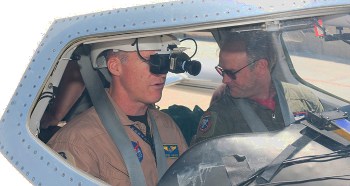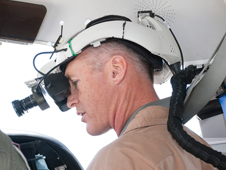 |
| January 22, 2013 | Volume 09 Issue 03 |
Designfax weekly eMagazine
Archives
Partners
Manufacturing Center
Product Spotlight
Modern Applications News
Metalworking Ideas For
Today's Job Shops
Tooling and Production
Strategies for large
metalworking plants
Fused Reality: NASA flyers blend reality and simulation
By Jay Levine, NASA Dryden Flight Research Center

Dryden pilot Troy Asher readies himself in the cockpit of a Learjet that once at altitude will use the new Fused Reality flight simulator for an aerial refueling drill. [Photo: NASA/Tom Tschida]
Computer-based simulation is an excellent flight-test tool that has been used for decades to allow pilots an opportunity to train in an unfamiliar aircraft or to gain experience and confidence for a new mission or flight research task.
Although some flight simulation systems include full-motion aspects similar to being in a real aircraft, a disadvantage of many computer-based simulators is that they lack some of the cues that come with that experience, and the pilot does not have the sense of being in the cockpit. Systems Technology Incorporated, or STI, of Hawthorne, CA, developed a new simulation system that can bridge that gap as part of a Small Business Innovative Research Phase II agreement with NASA's Dryden Flight Research Center.
STI's new system is called Fused Reality. It allows a pilot to use a blend of actual flying and a flight environment incorporating both live video and computer-generated virtual reality to provide for the most realistic simulation experience currently available. Dryden research engineer and technical representative Bruce Cogan said the company's success would not only benefit Dryden, but NASA as overall.
"They delivered beyond what was expected and they are providing us with a system that will allow us to take the next step, which is putting the system in a NASA aircraft to support flight research experiments," said Cogan. "This will be possible by interfacing Fused Reality with a Piccolo autopilot (a commercially available flight management system) to provide aircraft position data. It (Fused Reality) is good technology that NASA can really use."
Aerial refueling training is one example of how this technology can be used. While the aircraft is in flight, the pilot wears a unique helmet that combines the real out-the-window sky view from a camera with a view of the refueling drogue and tanker aircraft from a virtual reality element of the simulation.

Dryden pilot Troy Asher is seen from another view of the Fused Reality helmet. [Photo: NASA/Tom Tschida]
The environment through the helmet is achieved through a video board and an image generator drawing from live video. Sunlight from the aircraft's windows provides the virtual frame for the virtual world, explained Edward Bachelder, STI technical director and inventor of Fused Reality.
"Sensors on the aircraft add to the flight simulator. It's the motion of the aircraft that drives the simulation," Bachelder said.
Following a successful set of ground tests this past summer, Dryden pilots Troy Asher and Jim Less flew the system on Calspan Corporation's Variable Stability In-flight Simulator, a modified Learjet 25.
"It is a cross between a simulator and a video game," Asher said. "It's not like anything I've seen before. You get into the familiar environment of the airplane, and the goggles display virtual objects (like a tanker out the window) on top of what's really there. It's like being in a very realistic cartoon where all the acceleration and tactile cues come from the airplane."
"This system has great potential for training and flight test," added Less. "In flight test, this system would allow us to evaluate experimental control laws against operationally representative tasks such as aerial refueling, formation flying, target tracking, or even landing. These tasks would be displayed virtually to the pilot and could be accomplished safely away from the ground and other aircraft. This would permit more realistic testing of new systems with greatly reduced risk," he said.
Fused Reality could be used on a number of Dryden research and mission-support aircraft including the T-34, the TG-14 and the F/A-18, Cogan explained. The system may also have a role in NASA's Aviation Safety Program as part of flight research programs at Wichita State University and the University of Iowa, he added.

Dryden researchers had an opportunity to "fly" the Fused Reality system during a presentation at Dryden this past summer. [Photo: NASA/Tom Tschida]
STI CEO David R. Landon said with the Fused Reality system, "The magic is in the math, not in the hardware." In other words, the system's complex algorithms, or mathematical equations, are what make it work.
Landon said a customer could invest in the most modern computer, helmet-mounted display and the latest version of the Fused Reality software every few years and turn any cockpit, in about 30 minutes, into a simulator at a fraction of the cost of building a new one or upgrading a current simulator.
In addition to STI, key partners in the Fused Reality simulation development included Calspan and the Air Force Test Pilot School at Edwards Air Force Base.
NASA provided the financial support for STI to develop this new technology as part of NASA's mission to develop and commercialize technology that benefits both NASA and the nation.
"We could not have developed this without NASA," Bachelder commented. "NASA provided the dollars and the inspiration."
Published January 2013
Rate this article
View our terms of use and privacy policy
